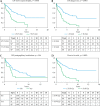Visual outcome after posterior uveal melanoma episcleral brachytherapy including radiobiological doses
- PMID: 29789761
- PMCID: PMC5961527
- DOI: 10.5114/jcb.2018.75597
Visual outcome after posterior uveal melanoma episcleral brachytherapy including radiobiological doses
Abstract
Purpose: To assess the long-term influence of radiobiological doses in the evolution of visual acuity (VA) in patients with uveal melanoma treated by episcleral brachytherapy.
Material and methods: Visual acuity was evaluated prospectively from a case series of 243 patients in 2016 treated with 125I. Data analysis was applied to trend VA outcome and find the accurate best-fit line. Biologically effective dose (BED) was included in survival analysis with the use of Kaplan-Meier and Cox regressions. Hazard ratio (HR) and confidence interval at 95% (CI) were determined. Variables statistically significant were analyzed and compared by log-rank tests.
Results: The median follow-up was 74.2 months (range, 3-223). Exponential regression shows a 25% reduction and 50% in visual acuity score (VAS) scale for 5 and 27.8 months, respectively. Cumulative probabilities of survival analysis were 57%, 42%, 27%, and 23% at 3, 5, 10, and 15 years, respectively. Multivariable analysis found tumor height (HR = 1.18, 95% CI: 1.07-1.29), applicator size (HR = 1.22, 95% CI: 1.08-1.36), juxtapapillary localization (HR = 1.70, 95% CI: 1.01-2.84), and dose to foveola (HR = 1.01, 95% CI: 1.00-1.01) significantly associated with VA loss. Log-rank tests were significant for all those variables. BED has a strong influence in univariate model, but not statistically significant in the multivariate one.
Conclusions: Visual acuity changes can be modeled by an exponential function for the first 5 years after treatment. No relation between VA loss and BED has been found; nevertheless, apical height, plaque size, juxtapapillary localization, and dose to fovea were found as statistical significant variables.
Keywords: brachytherapy; plaque brachytherapy; radiobiological doses; radiobiology; uveal melanoma.
Figures



References
-
- Singh AD, Turell ME, Topham AK. Uveal melanoma: trends in incidence, treatment, and survival. Ophthalmology. 2011;118:1881–1885. - PubMed
-
- Margo CE. The Collaborative Ocular Melanoma Study: an overview. Cancer Control. 2004;11:304–309. - PubMed
-
- Singh AD, Kivelä T. The collaborative ocular melanoma study. Ophthalmol Clin North Am. 2005;18:129–142. - PubMed
-
- ICRU Dosimetry of Beta rays and low-energy photons for brachytherapy with sealed sources. J ICRU. 2004;4:21–89. - PubMed
LinkOut - more resources
Full Text Sources
Other Literature Sources
